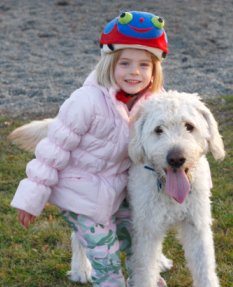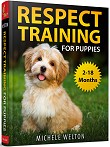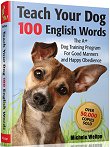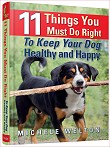The Truth About Crossbred Dogs
By Michele Welton, Dog Trainer, Breed Selection Consultant, Author of 15 Dog Books

Often called a "Goldendoodle", this is a cross between a Golden Retriever and a Standard Poodle.
The most common kind of crossbred (or crossbreed) dog is one purebred dog bred to another purebred dog of a different breed.
For example, a Golden Retriever crossed with a Standard Poodle produces crossbred offspring called "Goldendoodles."
Some people call them hybrid dogs, but that's wrong. You only get a hybrid when you cross two different species. For example, a horse bred to a donkey produces a hybrid we call a "mule".
Dog breeds are NOT different species. A dog "breed" is simply an inbred family of dogs within the same species: canis familiaris. The inbreeding (doubling up of the same genes) is what makes a dog breed look alike.
Some people call crossbred dogs designer dogs. But that's kind of silly, because purebred dogs are just as much designed as crossbred dogs. For example, breeders designed Border Collies by choosing specific traits that would help their dogs to be expert herders. Border Collies are just as much designed as Goldendoodles.
Some crossbreeds have been given "names"
You may have seen crossbred dogs marketed with cutesy names:
- Labradoodle (Labrador Retriever crossed with Poodle)
- Cockapoo (Cocker Spaniel crossed with Poodle)
- Schnoodle (Miniature Schnauzer crossed with Poodle)
- Puggle (Pug crossed with Beagle)
Whether a cross has been given a name or not doesn't matter. It's still a crossbred dog. For example, if a Siberian Husky mates with a Dalmatian, the resulting puppies will be crossbred even though no specific name has been coined for a Siberian-Dalmatian cross. Sibermatian, anyone?
Purebred A + Purebred B = crossbred puppies. No cutesy names required.

Often called a "Puggle, this is a cross between a Pug and a Beagle. Beware: lots of shedding!
Two more ways to get a crossbred dog
A purebred Pug crossed with a purebred Beagle produces crossbred puppies. That one's easy.
But also.... a purebred Pug crossed with a dog who is himself a Pug/Beagle cross STILL produces crossbred puppies. There are still just two breeds there: the purebred Pug contributes Pug genes, while the Pug/Beagle cross produces Pug and Beagle genes. So the pups inherit Pug and Beagle genes. That makes them crossbreeds.
Finally, a Pug/Beagle crossed with another Pug/Beagle STILL produces Pug/Beagle crossbred puppies, because again, there are only two breeds contributing the puppies' genes.
Many owners think they have a crossbred dog.... but they really don't
Many dog owners declare with confidence that their dog is a "Labrador cross" or a "Shepherd-Husky" or some such. But unless they know for a fact who bred the dog, and unless that person can guarantee who the parents were, such declarations are simply speculation.
And it makes little difference who's doing the speculating. Many owners ask their vet, but just as veterinarians know very little about dog training and behavior, they know very little about dog breeds.
Similarly, animal shelters love putting breed names on cages, but they also know very little about the breeds. If it's medium-large with shortish black hair, they'll guess "Lab cross." If it has prick ears, curled tail, and thick coat, they'll guess "Husky cross." If it's smallish with wiry hair... "terrier cross."
The surprising reality is that if a dog isn't a purebred, the chances are much higher that it's a mixed breed (more than two breeds) than a crossbreed (two breeds).
Why is it more likely that a dog is a mixed breed rather than a crossbreed?
Because the chances are slim that a male purebred dog wandering around twon found another purebred dog, of a different breed, who happened to be female, who happened to be in heat (which occurs only twice a year for three weeks), AND whose heat period was within the limited fertile window (only a few days within that 3-week heat period).
Now of course such coincidences do happen sometimes. And some people breed crossbred dogs deliberately.
Other people happen to own, say, an unneutered male Bloodhound and an unspayed female Labrador, and the dogs accidentally "hook up" and voila – crossbred "Blabador" pups. (Do they bark incessantly? heh-heh)
So if you have a dog who isn't purebred, can you find out for sure whether he's crossbred or mixed breed – and which breeds are in his genetic make-up?
Yes! There's only one way to do that. You can have his DNA tested.
There are two veterinary companies online, Embark Vet and Wisdom Panel, that will test your dog's DNA and tell you which breed(s) are in his ancestry.
You can do this right from your own home. No vet visit. No blood tests.
These companies will mail you a little kit with cotton swabs, which you simply swirl inside your dog's cheek. His saliva contains his DNA. Mail the swabs back, and the company will tell you whether your dog is a crossbred or mixed breed, and which breeds are in his genetic make-up.
I think it's a lot of fun to find this out. You might believe that your dog is "mostly Lab" or "half Shepherd" or "a poodle/terrier cross." Now you can find out whether you were right or wrong!
Does it help to know which breeds are "in" a crossbred or mixed breed dog?
Let's say you've just gotten a pup who isn't purebred. Will finding out his breed composition mean you can predict what he will grow up to look like or act like? Will it help you raise or train your dog?
It might. However, even if you know which breeds are "in your pup", you don't know whether those individual DOGS were typical for their breed. There are many purebred dogs who don't look or act like their breed is supposed to.
For example, many Rottweilers love strangers. Many Pit Bulls love other dogs. Some Labrador Retrievers are shy or aggressive instead of friendly. Some Chihuahuas weigh 15 pounds instead of 6. If these atypical dogs produce puppies, their atypical genes and traits can be passed on. You might have one of those atypical puppies.
So just because your pup "has pure breeds" in his ancestry doesn't tell you what those individual dogs were like. Therefore you don't know which genes and traits they had available to pass on.
Finally, when a puppy's ancestors include two or more breeds, many of their genes may be conflicting.
For example, suppose one of your dog's breeds has genes for friendliness. Another has genes for standoffishness. Another has genes for aggression. When your puppy inherits a jumble of conflicting genes, you don't know which genes will "trump" the others, or which ones will blend together to form some intermediate result.
Advantages of crossbred dogs
Crossbred dogs tend to have a moderate appearance.
In The Truth About Purebred Dogs, I explain about the deformities that have been inflicted on many purebred dogs – tiny size, giant size, pushed-in face, protruding eyes, short legs, long back, floppy lips, long heavy ears, wrinkled folds of skin. Deformities can only be maintained by continuously breeding such dogs TOGETHER.
On the other hand, when a purebred dog with a deformity is bred to a purebred dog without that deformity, the crossbred puppies tend to have an intermediate look. For example, a Pug crossed with a Beagle produces puppies with more natural-looking faces (better for breathing), compared with purebred Pugs.
Crossbred dogs tend to have a moderate personality.

Labradoodles are a cross between a Labrador Retriever and a Poodle. They can make good family dogs – IF you provide enough exercise and training, because they are energetic.
Crossbreeding tends to produce a middle-of-the-road temperament that often fits better into the average household than the more "extreme" temperaments of many purebred dogs.
In The Truth About Purebred Dogs, you learned that most breeds were developed to do some type of work, such as herding, hunting, guarding. They needed traits that helped them accomplish their work, such as high energy, aggression, chasing, digging, barking, and independent thinking.
Unfortunately those traits can be, well, a bit of a nuisance when you just want a family pet.
But if you cross a breed with a certain "working behavior" with a breed that doesn't have it, the chances are good that at least some of the puppies won't have it or will have it in a watered-down form that's easier to live with.
Crossbred dogs tend to be healthier.
All dogs have defective genes. In fact, all living creatures do, including you and me! But often a defective gene doesn't cause any problems unless you have TWO copies of it – one from your mother and one from your father.
A purebred puppy has a higher risk of inheriting two copies, since his parents belong to the same breed and share so many of the same genes, including the same defective ones.
But parents of different breeds (assuming those breeds are not similar to each other) tend to have different defective genes. This minimizes the risk of their puppies getting two copies of the same bad gene. That's good.
Not only that, but the greater variety of genes that a crossbred puppy inherits tends to result in a stronger immune system and better physical and mental health. It's called genetic diversity and it is a healthy thing.
My best-selling books – now available FREE on my website
 Respect Training For Puppies: 30 seconds to a calm, polite, well-behaved puppy is for puppies 2 to 18 months old. Your puppy will learn the 21 skills that all family dogs need to know. Click here to read for free.
Respect Training For Puppies: 30 seconds to a calm, polite, well-behaved puppy is for puppies 2 to 18 months old. Your puppy will learn the 21 skills that all family dogs need to know. Click here to read for free. Teach Your Dog 100 English Words is a unique Vocabulary and Respect Training Program that will teach your adult dog to listen to you and do what you say. Click here to read for free.
Teach Your Dog 100 English Words is a unique Vocabulary and Respect Training Program that will teach your adult dog to listen to you and do what you say. Click here to read for free. 11 Things You Must Do Right To Keep Your Dog Healthy and Happy helps your dog live a longer, healthier life. Get my honest advice about all 11 Things before you bring home your new puppy, because some mistakes with early health care cannot be undone. Click here to read for free.
11 Things You Must Do Right To Keep Your Dog Healthy and Happy helps your dog live a longer, healthier life. Get my honest advice about all 11 Things before you bring home your new puppy, because some mistakes with early health care cannot be undone. Click here to read for free.
